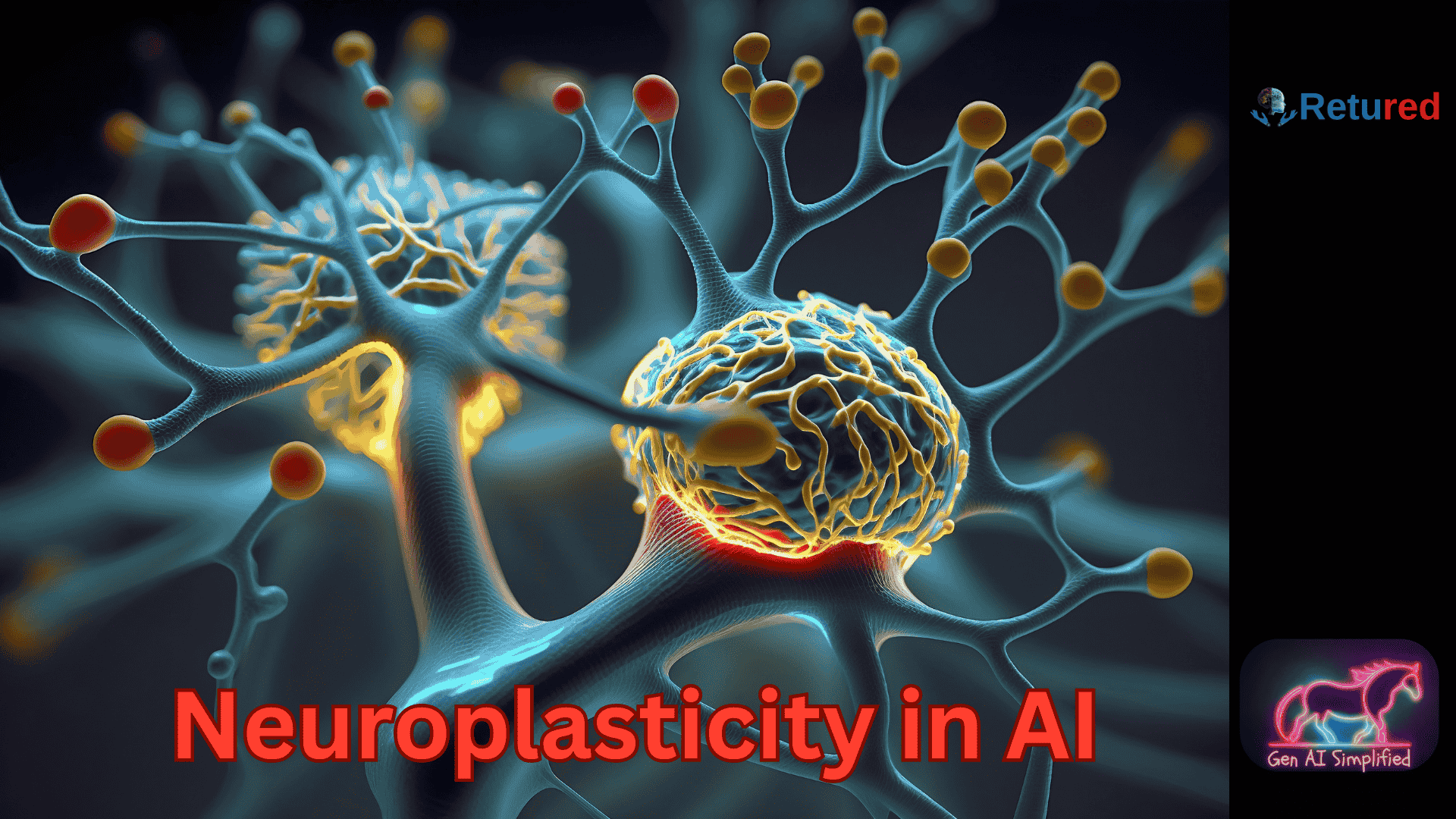“Every man can, if he so desires, become the sculptor of his own brain.” – Santiago Ramón y Cajal
Imagine you wake up one morning to find your coffee machine has grown extra buttons overnight, ready to prepare new exotic brews you didn’t even know existed. Far-fetched? For your kitchen appliances, certainly—but what if your AI could spontaneously grow new neurons, adapting dynamically to tasks at hand? Welcome to the intriguing world of artificial neuroplasticity, a groundbreaking frontier where artificial intelligence borrows inspiration from the human brain.
The Marvel of Biological Neuroplasticity
Biological neuroplasticity is the brain’s astonishing ability to reorganize itself by forming new neurons and connections. In humans, about 700 new neurons sprout daily in the hippocampus alone, continually refreshing our capacity for memory and learning. It enables us to master new languages, recover from strokes, and—crucially—adapt to life’s unending novelty.
Contrast this vibrant adaptability with traditional artificial neural networks (ANNs), where architectures are mostly rigid post-training. While ANNs adjust weights (synapse strengths), their structure rarely changes. Imagine a musician forever tuning a fixed set of strings rather than adding new ones—functional but limiting. AI has long faced the “stability–plasticity dilemma“: how to learn new things without forgetting old knowledge. Nature solves this with elegance, combining rapid adaptation (hippocampus) and slow consolidation (cortex).
Historical Glimpses: The Birth of Neuroplasticity in AI
Back in 1949, Donald Hebb famously observed, “Cells that fire together, wire together.” Early neural networks adopted Hebb’s learning principle but missed his deeper insight into structural adaptability.
It wasn’t until the late ’80s, with Grossberg’s Adaptive Resonance Theory, that AI explicitly tackled the stability-plasticity challenge. By the ’90s, models like Cascade-Correlation dynamically added neurons during learning—a form of artificial neurogenesis. Meanwhile, Yann LeCun’s intriguingly named paper “Optimal Brain Damage” showed that pruning connections (analogous to neural apoptosis) streamlined networks efficiently.
Humorously, AI researchers occasionally channel medieval barbers: trimming and shaping neural architectures to perfection, without necessarily regrowing lost connections. (Ouch, perhaps a less bloody metaphor next time!)
Modern Neuroplasticity: From Dropout to Dropin
Fast forward to the 2010s: the AI community inadvertently embraced artificial neuroapoptosis through Dropout—a technique randomly disabling neurons to prevent overfitting, somewhat akin to temporary neuron “naps.” Although effective, this was merely half the neuroplastic story.
Enter the revolutionary concept of “Dropin,” humorously named as dropout’s optimistic twin sibling. Dropin randomly activates new neurons during training, dynamically increasing a network’s capacity exactly when it’s stuck—like adding extra chairs at a crowded dinner table. In 2025, Yupei Li and colleagues formally introduced Dropin, advocating its combination with Dropout for truly plastic AI architectures.
Neuroplasticity and Large Language Models (LLMs)
Why bother growing neurons in large language models like GPT-4 or LLaMA? Consider the frustration when your chatbot confidently cites outdated information—like confidently discussing a “future” event already past. Static models struggle to integrate new knowledge without costly retraining.
Recent studies (Lo et al., 2024) showed astonishing resilience in large models: after pruning certain “neurons,” models quickly redistributed lost knowledge across surviving neurons. This hints at innate plasticity in current LLMs but still lacks structural adaptability.
Neuroplasticity—adding neurons to handle new tasks, pruning obsolete ones—could keep LLMs agile, ensuring your AI assistant doesn’t sound like it’s perpetually stuck in 2022.
Neuroplastic AI: Bridging Biological Inspiration and Practicality
Biology teaches AI that adaptability isn’t just beneficial—it’s crucial for survival. Dohare et al. (2024) discovered standard deep networks gradually “lose plasticity,” becoming rigid after sequential tasks. Injecting controlled randomness—think of it as occasional network “yoga stretches“—restored adaptability, demonstrating the necessity of continuous neuronal renewal for lifelong learning.
Li et al.’s unified Dropin-Dropout framework illustrates the harmony of growth and pruning, like gardening—knowing precisely when to plant new seeds or prune excess branches ensures optimal yield. Applied to AI, this approach means smarter, more efficient neural networks capable of perpetual self-optimization.
Comparing Neuroplastic AI with Retrieval-Augmented Generation (RAG) and Long Context Models
Current methods like Retrieval-Augmented Generation (RAG) and long-context models partly address AI’s limitations by externally storing knowledge or handling extensive textual contexts. However, RAG still relies on fixed architectures querying external databases, while long-context models often suffer computational inefficiency.
Neuroplasticity in AI offers a superior path—dynamically adapting internal structures to accommodate new information efficiently, without the constant retrieval or extensive computational overheads. Imagine RAG as continually searching a library, and neuroplasticity as updating your brain’s internal bookshelf for faster, direct access.
Challenges and Future Prospects
Implementing neuroplasticity isn’t without challenges. When should AI decide to “grow” new neurons, or prune old ones? Get it wrong, and you have an oversized, confused network or a knowledge-lost “pruned” model. The solution likely lies in AI monitoring its own learning—much like humans notice when they’re hitting cognitive limits (perhaps after the third coffee).
Practical trials will soon validate Dropin-Dropout approaches, potentially leading to neuroplastic LLMs becoming commonplace. Just imagine an AI assistant growing and adapting alongside you—perpetually fresh, relevant, and unfazed by life’s twists and turns.
Conclusion: Sculpting the Future of AI
Neuroplasticity brings a fresh, dynamic dimension to artificial intelligence. No longer static, AI systems could adapt, evolve, and learn indefinitely. It’s about making AI smarter, efficient, and more human-like in adaptability.
To paraphrase poet Emily Dickinson, the brain—yours or silicon—is wider than the sky, capable of continual expansion. The journey toward neuroplastic AI promises thrilling advances in lifelong learning, personalized experiences, and cognitive resilience.
Ready to explore more about the groundbreaking intersection of neuroscience and AI? Subscribe to the blog and stay at the forefront of artificial intelligence innovation. After all, in the dynamic world of AI, neurons that fire together… hire together!


Dr Bruce Long on the need for structurally and functionally heterogeneous ANN architectures over just scalability, Feb 25, 2024: https://medium.com/naturalistic/scalability-and-strong-ai-62882b1152a6?sk=5c2ebf83dc44e834c79b3495f5b7895d